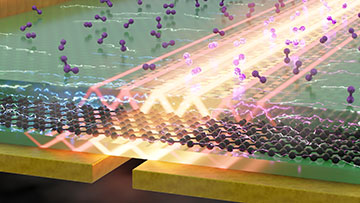
The on-chip device encodes the molecular response in a photocurrent that can be measured with a graphene-based detector. [Image: David Alcaraz, ICFO]
Researchers in Spain have created an on-chip device for infrared spectroscopy that can detect the characteristic vibrations of small organic molecules in layers as thin as 10 nm (Nat. Commun., doi: 10.1038/s41467-024-53182-9). The miniaturized device, which exploits a graphene-based detector to measure the absorption of infrared light by the molecules, offers a route toward chip-based platforms for gas sensing and molecular analysis.
Improved sensitivity
Infrared spectroscopy is widely used to identify molecules from the characteristic vibrations of their chemical bonds, but standard methods are unable to detect specific species in small quantities or concentrations. In recent years, the sensitivity has been improved through a technique called surface-enhanced infrared absorption (SEIRA) spectroscopy, in which the molecular samples are placed onto plasmonic structures that enhance the local light field and strengthen the coupling to the molecular vibrations.
Further improvements have been achieved by replacing the plasmonic structures with two-dimensional materials such as hexagonal boron nitride (hBN), which confine the light field more strongly to give an extra boost to the molecular signal. Indeed, earlier work by the researchers showed that this approach can identify small organic species in gases and molecular layers just a nanometer thick, although these experiments required bulky optical equipment to generate and detect the infrared light.
On-chip solution
Such an arrangement enhances the absorption of infrared light by the molecules, while also boosting the photocurrent generated in the graphene detector.
In this new work, the team created an on-chip solution that exploits an integrated graphene-based photodetector that, unlike the nitrogen-cooled photodetectors that are typically needed for SEIRA experiments, can be operated at room temperature. In the device, a single sheet of graphene is sandwiched between two thin layers of hBN, with a gated structure fabricated in the graphene to measure the photocurrent generated when a molecular layer deposited on top of the heterostructure is illuminated with infrared light. Such an arrangement enhances the absorption of infrared light by the molecules, while also boosting the photocurrent generated in the graphene detector.
Tests of the device reveal dips in the measured photocurrent at the characteristic frequencies of the molecular vibrations, with the on-chip design producing a stronger molecular response than a standard transmission experiment using the same graphene detector. What's more, the improvement in sensitivity is more pronounced for thinner molecular layers: At 10 nm, for example, the miniaturized device can detect a molecular signature that is not visible in the transmission spectra.
“One of the most exciting aspects of this approach is that the graphene-based detector opens the way towards miniaturization,” comments Sebastián Castilla from the Institute of Photonic Sciences (ICFO). “By integrating this detector with microfluidic channels, we could create a true lab-on-a-chip, capable of identifying specific molecules in small liquid samples.”
